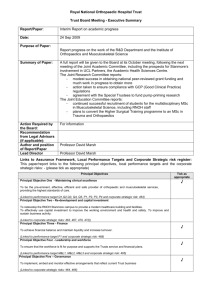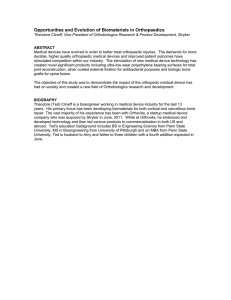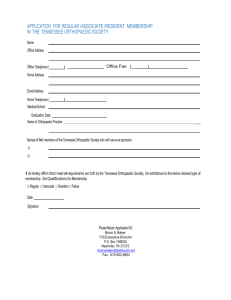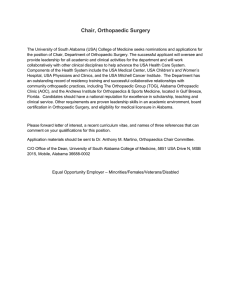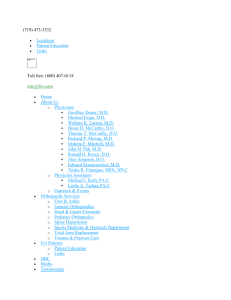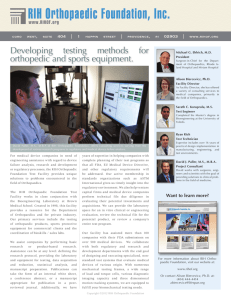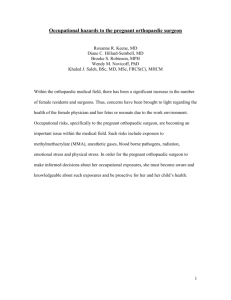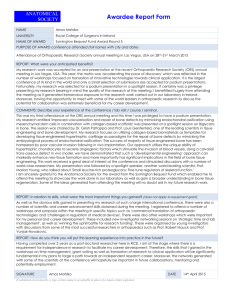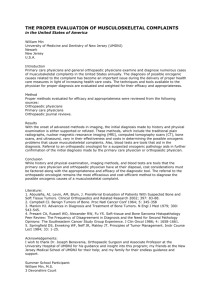Orthopaedic Science
advertisement
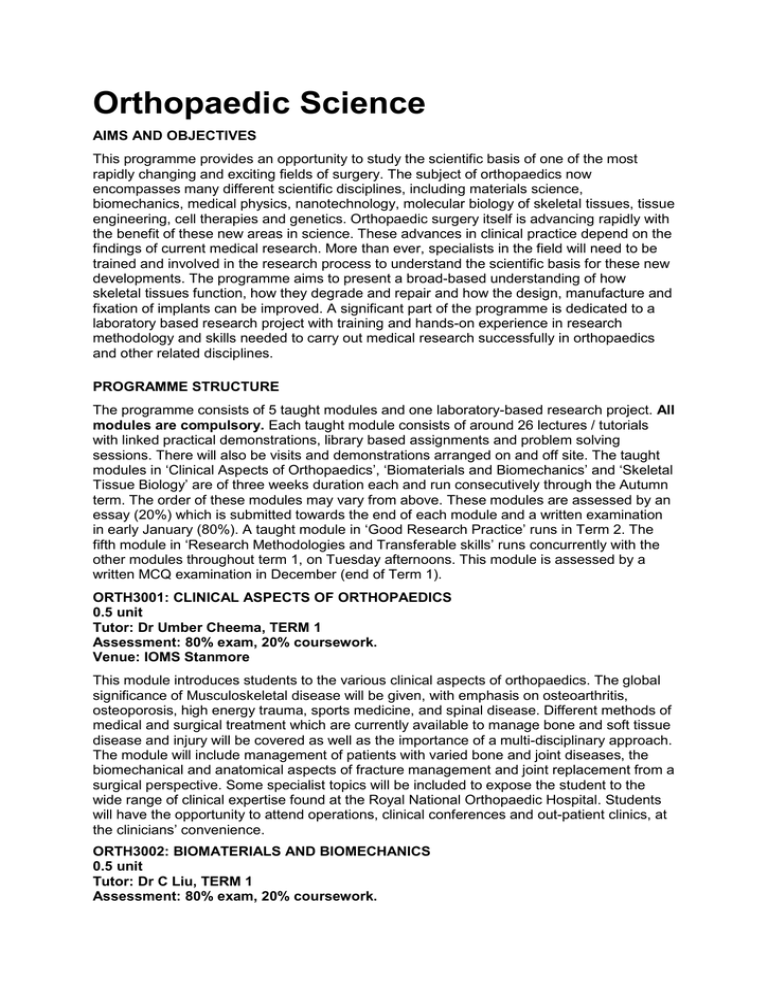
Orthopaedic Science AIMS AND OBJECTIVES This programme provides an opportunity to study the scientific basis of one of the most rapidly changing and exciting fields of surgery. The subject of orthopaedics now encompasses many different scientific disciplines, including materials science, biomechanics, medical physics, nanotechnology, molecular biology of skeletal tissues, tissue engineering, cell therapies and genetics. Orthopaedic surgery itself is advancing rapidly with the benefit of these new areas in science. These advances in clinical practice depend on the findings of current medical research. More than ever, specialists in the field will need to be trained and involved in the research process to understand the scientific basis for these new developments. The programme aims to present a broad-based understanding of how skeletal tissues function, how they degrade and repair and how the design, manufacture and fixation of implants can be improved. A significant part of the programme is dedicated to a laboratory based research project with training and hands-on experience in research methodology and skills needed to carry out medical research successfully in orthopaedics and other related disciplines. PROGRAMME STRUCTURE The programme consists of 5 taught modules and one laboratory-based research project. All modules are compulsory. Each taught module consists of around 26 lectures / tutorials with linked practical demonstrations, library based assignments and problem solving sessions. There will also be visits and demonstrations arranged on and off site. The taught modules in ‘Clinical Aspects of Orthopaedics’, ‘Biomaterials and Biomechanics’ and ‘Skeletal Tissue Biology’ are of three weeks duration each and run consecutively through the Autumn term. The order of these modules may vary from above. These modules are assessed by an essay (20%) which is submitted towards the end of each module and a written examination in early January (80%). A taught module in ‘Good Research Practice’ runs in Term 2. The fifth module in ‘Research Methodologies and Transferable skills’ runs concurrently with the other modules throughout term 1, on Tuesday afternoons. This module is assessed by a written MCQ examination in December (end of Term 1). ORTH3001: CLINICAL ASPECTS OF ORTHOPAEDICS 0.5 unit Tutor: Dr Umber Cheema, TERM 1 Assessment: 80% exam, 20% coursework. Venue: IOMS Stanmore This module introduces students to the various clinical aspects of orthopaedics. The global significance of Musculoskeletal disease will be given, with emphasis on osteoarthritis, osteoporosis, high energy trauma, sports medicine, and spinal disease. Different methods of medical and surgical treatment which are currently available to manage bone and soft tissue disease and injury will be covered as well as the importance of a multi-disciplinary approach. The module will include management of patients with varied bone and joint diseases, the biomechanical and anatomical aspects of fracture management and joint replacement from a surgical perspective. Some specialist topics will be included to expose the student to the wide range of clinical expertise found at the Royal National Orthopaedic Hospital. Students will have the opportunity to attend operations, clinical conferences and out-patient clinics, at the clinicians’ convenience. ORTH3002: BIOMATERIALS AND BIOMECHANICS 0.5 unit Tutor: Dr C Liu, TERM 1 Assessment: 80% exam, 20% coursework. Venue: IOMS Stanmore This module is designed to allow students to develop further their understanding of the mechanical aspects of skeletal tissue disease, injury and repair and the biomaterials used in orthopaedic surgery. Students will learn about forces, stress, strain, elasticity and viscoelasticity and will investigate how these material properties are determined. The mechanical function of natural and artificial joints, tendons, ligaments and bone are related to their material properties, organisation and geometry. Other topics cover kinematics and kinetics of joints, analysis of gait, and the measurement of bone/joint forces in vivo. A visit to an orthopaedic manufacturing company and a gait analysis laboratory will also take place. Students will learn in greater depth about the biomaterials used in clinical applications. Biomaterials are either natural or synthetic materials, which find applications in a wide spectrum of medical implants and prostheses. This course covers the majority of biomaterials in current use, and includes composition, interaction and integration with adjacent tissues. In addition, novel bone analogue materials under development and the incorporation of biologically active agents and the role of biomaterials as drug delivery systems are covered. ORTH3003: SKELETAL TISSUE BIOLOGY 0.5 unit Tutor: TBA, TERM 1 Assessment: 80% exam, 20% coursework. Venue: IOMS Stanmore This module will deal with the composition of skeletal tissues from the macroscopic to the molecular level and provide information to explain the mechanical behaviour of the tissues discussed in the next module. The major molecular components of connective tissues will be described including collagens, elastic fibres and proteoglycans. Connective tissue cell types, their functions and role in maintaining the skeletal tissues will also be discussed and the response of cells to their physiological and mechanical environment will be included. For specific tissues (bone, tendon/ligament, cartilage, fibrocartilage) the relationship between structure and functional requirements will be covered. Age related, exercise related and degenerative changes to these skeletal tissues will be included and possible mechanisms involved in skeletal tissue disease, injury and repair discussed. ORTH3004: RESEARCH METHODOLOGIES AND TRANSFERABLE SKILLS 0.5 unit Tutors: Dr C Pendegrass, TERM 1 Assessment: 100% exam. Venue: UCL Bloomsbury This module introduces the skills required to conduct research and to understand and critically evaluate research output produced by others. It includes basic approaches to scientific writing and critical analysis of published work, together with bibliographic information management and presentation skills. A substantial proportion of the module is concerned with understanding data and how it can be analysed: variables, statistical methods and how to interpret results. The design of research (including clinical) studies, the principles of epidemiology and the ethical considerations in both laboratory and clinical research are also covered. The contents of the module will be useful in preparing for students’ own projects. ORTH3005: GOOD RESEARCH PRACTICE 0.5 unit Tutor: Dr M Coathup, TERM 2 Assessment: 100% Coursework. Venue: IOMS Stanmore This module will teach the techniques and practices of basic and clinical research. This will complement the research project, and will run concurrently with it (0.5 day per week). Basic and clinical research staff from different disciplines will show how they run their research, and give examples of actual projects. This will include the elements of Good Research Practice and Good Clinical Practice. Students will further develop their understanding of statistics from ORTH3004 by using specific statistical analyses with their project data. Assessment will be by Coursework. ORTH3901: LABORATORY RESEARCH PROJECT 1.5 units Tutor: Dr S Taylor, TERMs 2&3 Assessment: 80% project dissertation and 20% viva. Venue: IOMS Stanmore Commencing at the end of the Autumn term and continuing through the Spring term students will undertake a laboratory-based research project. The research projects are randomly allocated at the start of Term 1(with option for swapping by mutual agreement), and are supervised by academic, clinical and post-doctoral research staff at the Institute. These topics will be in areas linked to the researcher’s current work and the student will form part of the research group for the duration of the project. Project work is written up in the form of a thesis and students are encouraged to submit their work for presentation at relevant conferences and for publication in peer-reviewed journals. The research project is assessed by a written report (80%) and a viva examination (20%) in May. EXAMPLES OF RECENT RESEARCH PROJECTS An Engineering Solution to Foot Drop Balance Measurements in Joint Hypermobility Does Porosity explain Discrepancy between Quantitative Radiography and Raman Spectroscopy Measurements of Bone? The Protective Nature of Hydroxyapatite Collars on Massive Prostheses The Use of Porous, Strontium containing Bioglass as a Bone Graft Substitute Material Development if a protocol for the Isolation and Culture of MSC’s from Synovial Tissue Biomechanical properties of a biomimetic IVD Replacement Does Hamstring Weakness Contribute to Decrease Range of Motion Post Total Knee Replacement? Why Do Femoral Stems Fracture in Patients with Total Hip Replacements? The Rejuvenating Effect of GDF-11 on the Migration, Proliferation and Osteogenic Differentiation of Senile, Osteopenic Mesenchymal Stem Cells An Osteogenic Comparison of Adipose, Periosteal and Bone Marrow Derived Mesenchymal Stem Cells and Are they Immunopriviledged? A Non-Invasive Set-Up to Investigate the Impact of the Ankle-Foot Orthosis on the Biomechanics of a Recumbant Tricycle Biological Assisted Corrosion of Metal Implants Increasing the Bioactivity of Polyetheretherketone PREVIOUS RESEARCH PROJECTS EXAMPLE PUBLICATIONS Recent Journal papers (iBSc student’s name in BOLD) Malikian R, Maruthainar K, Stammers J, Cannon SR, Carrington R, Skinner JA, Maruthainar N, Dowd G, Briggs TW, Blunn GW. In vivo roughening of retrieved total knee arthroplasty femoral components. Knee. 2012 Nov 8. doi:pii: S0968-0160(12)00160-3. Mordecai SC, Lambert SM, Meswania JM, Blunn GW, Bayley IL, Taylor SJ. An experimental glenoid rim strain analysis for an improved reverse anatomy shoulder implant fixation. J Orthop Res. 2012 Jun;30(6):998-1003. Vijayan S, Bartlett W, Bentley G, Carrington RW, Skinner JA, Pollock RC, Alorjani M, Briggs TW. Autologous chondrocyte implantation for osteochondral lesions in the knee using a bilayer collagen membrane and bone graft: a two- to eight-year follow-up study. J Bone Joint Surg Br. 2012 Apr;94(4):488-92. Chan O, Coathup MJ, Nesbitt A, Ho C-Y, Hing KA, Buckland T, Campion C, Blunn GW. The effects of microporosity on osteoinducation of calcium phosphate bone graft substitute biomaterials. Acta Biomater, 8(7):2788-94, 2012. Pendegrass CJ, Tucker B, Patel S, Dowling R, Blunn GW. The effect of adheren junction components on keratinocyte adhesion in vitro: potential implications for sealing the skinimplant interface of intraosseous transcutaneous amputation prostheses. J Biomed Mater Res A 100(12):2463-71, 2012. Ghani Y, Coathup MJ, Hing KA, Blunn GW. Antibacterial effect of incorporating silver ions in electrochemically deposited hydroxyapatite coating: An experimental study. JRSM Short Rep. 4(9), 2013. Wek CA, Kelly CP, John J, Blunn G. Histological evaluation of retrieved Copeland resurfacing shoulder arthroplasties. JRSM Short Rep. 4(10), 2013. Rich H, Odlyha M, Cheema U, Mudera V, Bozec L. Effects of photochemical riboflavinmediated crosslinks on the physical properties of collagen constructs and fibrils. J Mater Sci Mater Med. 2014 Jan;25(1):11-21. Lancashire HT, Jenkins V, Pendegrass CP, Blunn GW. Multi-Scale Topographies for PC-12 Cell Neurite Alignment: an in vitro study. In preparation, 2014. Example Oral Presentations Lancashire HT, Jenkins V, Pendegrass CP, Blunn GW. Basement Membrane Protein Coatings for In Vitro Neural Regeneration for Nerve Electrodes. Accepted for Oral Presentation at the 25th European Conference on Biomaterials, Madrid, 2013. Coathup MJ, Ahmad S, Briggs T, Aston W, Blunn GW. A retrospective study comparing the survivorship of non-invasive and minimally invasive extendible bone tumour implants. Poster presentation at the British Orthopaedic Research Society, Oxford, 2013. Coathup MJ, Ahmad S, Skinner J, Cannon S, Polloack R, Briggs T, Aston W, Blunn GW. The survivorship of non-invasive and minimally invasive extendable bone tumour prostheses: a retrospective study. Podium presentation at the International Society for Limb Salvage, Bolgna, Italy, 2013. Erskine K, Coathup MJ, Garrod D, Blunn GW. A histomorphometric and biomechanical evaluation of the osseointegration of laser etched implants in an ovine model. Podium presentation at the British Orthopaedic Research Society, Oxford, 2013. Poursaeidi R, Shah K, Coathup MJ, Cobb J, Briggs T, Cannon S, Pollack R, Aston W, Blunn GW. A mid-term follow-up of knee joint-sparing massive endoprostheses. Poster presentation at the International Society for Limb Salvage, Bolgna, Italy, 2013. Prizes awarded Barian Mohidin. Best paper. British Orthopaedic Research Society, London, 2012. Barian Mohidin. Jackson Lewis Award. Distinguished academic performance, UCL 2012. Raizi Zaidi. Best paper. The British Orthopaedic Foot and Ankle Society, 2012. Prasad Sawadkar. Best paper. TERMIS EU 2013. THE INSTITUTE The staff of the Institute of Orthopaedics and Musculoskeletal Science (IOMS), many of whom are internationally recognised leaders in their field, are actively engaged in clinical work, research and teaching at both postgraduate and undergraduate levels. The Institute is closely associated with and is on the site of the Royal National Orthopaedic Hospital Trust. The Institute is a multi-disciplinary department dedicated to education and training in orthopaedic surgery and research in to the aetiology, diagnosis and management of diseases and injuries of the musculoskeletal system. Postgraduate teaching and training are provided through educational courses in orthopaedics and related subjects as part of the combined training scheme organised jointly by the Institute and the Royal National Orthopaedic Hospital Trust. In addition to orthopaedic surgery, basic sciences, radiology, biomedical engineering, pathology, rehabilitation and physiotherapy are taught either as part of the programme for surgeons in training or to those specialising in the different fields. The Institute and the Royal National Orthopaedic Hospital Trust have developed a number of special clinical units whilst retaining general orthopaedic activities for teaching. THE ROYAL NATIONAL ORTHOPAEDIC HOSPITAL The Royal National Orthopaedic Hospital (RNOH) was founded in 1905 with the amalgamation of London’s three specialist orthopaedic hospitals into a single centre of excellence and can thus trace its history back to 1838 when the Royal Orthopaedic Hospital was founded. Since its inception, the hospital has become an acknowledged world leader in its field, offering a breadth of specialist services unrivalled in the United Kingdom, and matched only by a couple of centres world-wide. The RNOH working in partnership with University College London’s Institute of Orthopaedics and Musculoskeletal Science forms the hub of the country’s most comprehensive training course for orthopaedic surgeons. Within an environment of teaching and research, the aim is to maintain the highest standards of care and to provide top quality teaching for patients with disorders and injuries of the musculoskeletal system. RECREATIONAL FACILITIES In addition to a limited amount of accommodation, the campus of the Royal National Orthopaedic Hospital Trust offers sports facilities which include a fully equipped sports hall, weight training room and swimming pool. CONTACT DETAILS A limited number of places are available. For further details or to discuss the programme contact Dr Stephen Taylor, Course Tutor, stephen.taylor@ucl.ac.uk or Miss Stephanie McColl (Courses Co-ordinator, Institute of Orthopaedics and Musculoskeletal Science, RNOH Trust, Brockley Hill, Stanmore, Middlesex HA7 4LP, Tel: 0208 909 5850). s.mccoll@ucl.ac.uk
